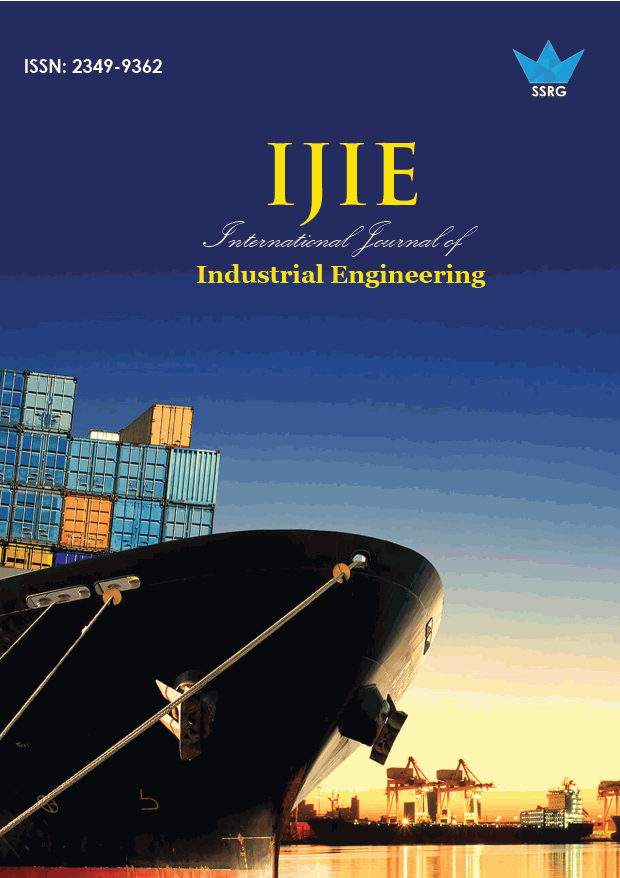Machine Learning Can Maximize Efficiency in an Industrial Process

| International Journal of Industrial Engineering |
| © 2021 by SSRG - IJIE Journal |
| Volume 8 Issue 1 |
| Year of Publication : 2021 |
| Authors : Wolfgang Mergenthaler, Daniel Jaroszewski, Salah-Eddine Morsili, Benedikt Sturm |
How to Cite?
Wolfgang Mergenthaler, Daniel Jaroszewski, Salah-Eddine Morsili, Benedikt Sturm, "Machine Learning Can Maximize Efficiency in an Industrial Process," SSRG International Journal of Industrial Engineering, vol. 8, no. 1, pp. 14-20, 2021. Crossref, https://doi.org/10.14445/23499362/IJIE-V8I1P103
Abstract:
Continuous industrial manufacturing processes are generally controlled by a set of continuous control variables. The process usually produces a steady flow of output material, such as cement, food, milk, chemicals, and sugar or electrical power in a power plant. Control variables may be electrical or fossil power, cooling or heating, lubrication, pressure, etc. The process responds with a given flow of output measured in tons per day or power expressed in Megawatt. Dividing the input power response yields a variable proportional to the degree of efficiency of the process, which is a very important parameter in most cases. To understand, analyze or predict the process, in a first step, we will approximate the empirical response values by a smooth function, mapping the space of controls onto the interval [0,100%], using Machine Learning Techniques and Multivariate Statistics such as Tensor Flow or Generalized Linear Models (GLMs), respectively. Both approaches provide suitable approximation measures. In a second step, the process will be optimized within a given set of constraints concerning the control variables. This step will be illustrated by GLMs only due to their lack of overfitting and their continuous differentiability properties. This way, optimal set points, and sensitivity coefficients will be given.
Keywords:
Machine Learning, Tensor Flow, Generalized Linear Models, Nonlinear Optimization, Sensitivity Coefficients
References:
[1] M. Abadi et al., Tensor Flow: Large Scale Machine Learning on Heterogeneous Distributed Systems (Preliminary White Paper, November 09, 2015). http://download.tensorflow.org/paper/whitepaper pdf ., (2015).
[2] B. Benesova, M. Kruzik, Weak Lower Semi continuity of Integral Functionals and Applications, SIAM Review, 59(4)(2017) 703-766
[3] J.L. Crassidis, J.L. Junkins, Optimal Estimation of Dynamic Systems. Chapman & Hall/CRC, Boca Raton (2004).
[4] D. E. Goldberg, Genetic Algorithms in Search, Optimization, and Machine Learning. Addison-Wesley, Reading (MA) (1989).
[5] I. Koch, Analysis of Multivariate and High-Dimensional Data Cambridge University Press, New York (2014) 148
[6] D. Kriese, Ein kleiner Ueberblick ueber Neuronale Netze, www.dkriesel.com/imprint, Rheinbach, Germany., (2018)
[7] F. Kuebler et al., Resource efficiency optimization of manufacturing processes using evolutionary computation: A turning case. Procedia CIRP 29(2015) 822-827, www.elsevier.com/locate/procedia
[8] Z. Michalewicz, How to Solve It: Modern Heuristics. Springer, Berlin-Heidelberg (2000).
[9] H. R. Myers, D.C. Montgomery, C.M. Anderson Cook, Response Surface Methodology. Wiley, New York (2009).
[10] K. Naeem et al., Process Optimization of a Local Steel Bar Manufacturing Firm Using SPC and ANOVA, International Journal of Engineering Research and Development,10 (7)(2014) 10-15.
[11] Klaus Neumann, Martin Morlock, Operations Research. Carl Hanser, Muenchen, Wien (1993) 337
[12] M. L. Pinedo, Planning and Scheduling in Manufacturing and Services. Springer, New York (2005).
[13] S. Sousa et al., Application of SPC and quality tools for process improvement, 27th International Conference on Flexible Automation and Intelligent Manufacturing, FAIM, 27-30 (2017) Modena, Italy, ELSEVIER, Science Direct, Procedia Manufacturing, www.sciencedirect.com.
[14] E. K. Tetteh, S. Rathilal, Application of Response Surface. Methodology (RSM) - Reduction of Industrial Wastewater Chemical Oxygen Demand. CBU International Conference on Innovations in Science and Education, Prague, ( 2017).
[15] M. Lapan, Deep Reinforcement Learning, Hands-On, Packt Publishing, Birmingham (2018).

 10.14445/23499362/IJIE-V8I1P103
10.14445/23499362/IJIE-V8I1P103